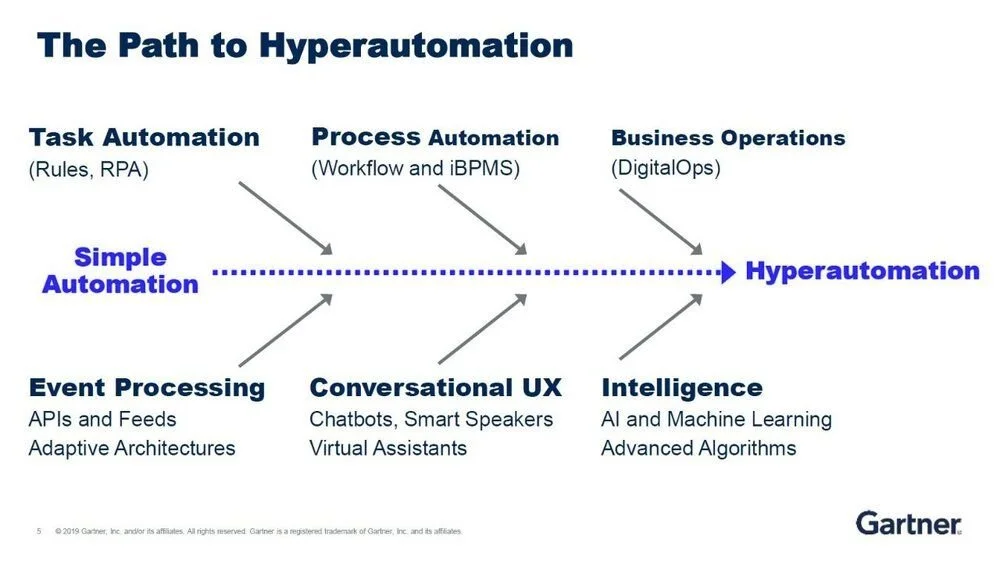How to hyper-automate your residential operations
One of the top trends on the Gartner Top Strategic Technology Trends for 2022 is Hyperautomation. The Gartner Glossary defines Hyperautomation as:
"... a business-driven, disciplined approach that organizations use to identify rapidly, vet, and automate as many business processes as possible. Hyperautomation involves the orchestrated use of multiple technologies, tools, or platforms, including Artificial intelligence (AI), Machine learning, Event-driven software architecture, Robotic process automation (RPA), business process management (BPM), and intelligent business process management suites (iBPMS), Integration platform as a service (iPaaS), Low-code/no-code tools, Other types of decision, process and task automation tools."
How is Hyperautomation relevant to residential operations?
1 in 3 residential operators has the mandate to centralize and automate their operations by 2024. The pressures of labor supply, customer expectations, and data expectations of LPs have prioritized the need for automation initiatives. But the domain of onsite management is very varied and opaque, which means that simple automation has a meager impact on productivity or bottom lines. But, the pursuit of hyper-automation can automate end-to-end operational streams beyond standard rules by combining a domain-trained and sophisticated machine learning platform with conversational intelligence. ADAM is the perfect partner in the industry's journey to hyper-automation.
Getting Started for Success - Process Mining
Organizations like to "automate" with bias. The department with the most budget, churn, or other indicator defines a need, and automation proposals are submitted. However, this method does not apply to sustainable hyper-automation. The first and most crucial step for transformation is Process Mining. In simple words, it's the activity of understanding the onsite tasks and gathering operational intelligence that can then help alter the existing process before automating. Traditionally, a group of internal or external consultants would 'shadow' or simulate with your onsite teams to map their tasks and then suggest improvements. However, the biggest problem that large operators face is that every community is unique. It may be a consequence of inherited practices from a previous owner or just the evolution for customization for a single building. Also, a lot of operational peaks are seasonal. The greatest challenge in operations is exception handling, which requires a longer time frame of observation. Operators need to study their teams effectively over an extended period, multiple channels, and communities to process mine effectively. However, using a conversational interface with domain training like ADAM, this data is gathered accurately within weeks. ADAM behaves like a silent observer within the onsite teams and helps cluster trends and identify the patterns of operational bottlenecks.
Preparation for Automation - Digital Operations
Technology companies often talk about technical debt, but real estate operators rarely discuss the operational debt. When applied in an onsite scenario, processes designed in centralized offices are often not fit for purpose. On the contrary, complete flexibility and freedom for onsite operations are double-edged swords. It allows an excellent manager to perform to their potential but creates an intelligence void and loss of transparency for the central organization.
When designing your 'digital operations, ' adaptability is crucial.
It needs to provide the flexibility of applying consistent, centralized, and often 'branded' processes to make sense for scale and local variation. Onsite Digital Ops requires an event-based automation architecture instead of simple workflow software orchestration. ADAM provides this. Any process or automation can be triggered, either from centralized policies or replaced by local tools which are more relevant to a community.
Total Experience Management - Conversational UX
Any automation project needs to include both the employee and customer experience as a single strategy. Technology should not create friction for change. Most centralization and automation strategies are underpinned by the deployment of mobile apps or software for users to engage with. Staff training is an important factor and the strain of 'learning tech' is a pain point for property teams. After deploying a solution, switching becomes impossible because of the pressures of change. No one wants to communicate new app downloads to residents or retrain staff on new systems.Hyper-automation strategies mandate flexibility in architecture that can only be achieved with a natural and intuitive UX. Conversational UX provides this, with no learning curves or downloads allowing frictionless change. When ADAM has a conversation with a resident, for example, to update occupants’ contact details, he can seamlessly decide to trigger multiple RPA processes which can be swapped at any time without any experience of change to the user.
Employee and customer confidence is high when their experience is seamless. Natural language is the best fit for a flexible interface but it requires a quality of interaction that can only be achieved by dedicated domain-based conversational engines that straddle all channels and the entire domain. Deploying a Conversational UX that doesn’t understand the breadth and nuances of the entire Real Estate domain will lower confidence. ADAM has created this trust with over 80,000 residents who treat him like a human member of their community teams to achieve automation while retaining the personal touch.

